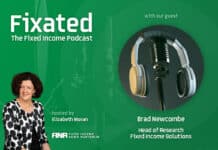
Trillions of dollars of household wealth have been lost because of the stock market rout. A nasty doom loop is in danger of developing as consumer and business confidence collapses. Shouting bad economic theory at every opportune press event is not going to stop it. Investors need to protect their wealth – more defensive, safe-haven asset classes will likely continue to perform better than equities. Credit markets have been more stable than equities, helped by lower interest rates. But as we approach the first quarter (Q1) earnings reporting season, the risk is that corporate America’s message about its financial outlook is not going to be good. Stocks have been expensive and credit spreads have been tight. The adjustment process against a collapse in economic sentiment has further to go.
Price and volume
Despite tariffs being about price (inflation), the market is focused on volume (growth). The so-called ‘Liberation Day’ liberated the bears – global stocks have been in free-fall; bond yields have dropped sharply, and the dollar has retreated against other major currencies. There is an unequivocal belief that President Donald Trump’s tariffs have significantly raised the risk of a US recession, and perhaps, elsewhere. Over the last few weeks, US surveys have been highlighting the consumer and corporate confidence collapse. More forecasters are explicitly predicting a US recession. If that is the case, we should expect corporate profit margins to plummet, net income to fall and price-to-earnings multiples in the equity market shrink. The Federal Reserve (Fed) has historically cut interest rates aggressively in recessionary periods. This is probably the road map ahead and more portfolio reallocations are likely to be necessary as a result. Market moves so far have been brutal. From its mid-February peak, the MSCI World Equity index had fallen 9.7% at the time of writing. In the US, indices are down much more; the S&P 500 fell 4.84% on 4 April; the Nasdaq dropped almost 6%. Market pricing is now for four Fed rate cuts this year.
Since 1980, US Treasuries have outperformed US equities for more than two consecutive quarters in 1982, 1992, 2001 and 2008-2009. These were all recessionary periods. If we are heading to a recession, the odds are that it will not just have been Q1 2025 that saw US bonds outperform US stocks. And if that is the case, the pattern is likely to be seen in other markets too.
Stagflation
In my first ever economics class I was introduced to the supply and demand graph. It shows us that, all else being equal, if the price of something goes up, demand for it will go down. The extent to which demand changes depends on the “elasticity of demand” for that good or service. If it is for example, an essential or low priced good – like bread, oil or a box of matches – demand won’t fall much. If it is non-essential, or there are credible substitutes, demand might fall by a lot more. How US companies and consumers react to the inevitable price and cost increases that will result from the tariffs depends on the good and whether there are realistic (American made) substitutes. The reaction will be complex but there will not be like-for-like substitutes for everything subject to tariffs. So, prices up, volumes down. That will show up in reduced real consumption in the US and reduced exports from the rest of the world. And universal tariffs means that the entire cost of imports goes up, including components and intermediate goods which feed into the sales cost for (mostly) American-made products. That raises the general price level – prices up, volume down. I hate the term, but it’s going to look like what a lot of people will call stagflation.
Also read: Why Do Markets Need to Stabilize?
Doom loop
For Asian and European based exporters, the tariffs mean reduced demand (because of higher prices their US customers will face) and reduced revenue if they choose to cut selling prices to offset the tariffs. Lower sales and revenues from the US are unlikely to be compensated for by dumping output to third party economies that are also being hit by tariffs. Globally, a trade war might mean the demand curve arguably shifts to the left – meaning volumes down and prices down, eventually. In other words, a disinflationary shock once the full implications of protectionism are seen. It will be made worse by the fact that the dollar is weakening.
Bleak for stocks
At the beginning of the year, the IBES (International Brokers Estimate System) consensus for aggregate earnings-per-share (EPS) growth in 2025 for the S&P 500 was 14%, with a 2025 EPS estimate of $270. Now that growth rate has been cut to 12.2% with a $266 target. The momentum on expectations is downwards. Readers would not expect otherwise, surely? The global trade system is being upended, price and volume trends point to reduced earnings, and in the technology sector, which drove profits growth in the last couple of years, the exorbitant rents of the early pioneers of generative artificial intelligence are coming down because of increased competition. Growth stories might re-emerge but not when policy is slamming down on free markets.
Bond bulls
Bond yields below 4% in the US and UK, and below 2% in Europe are likely in this deteriorating environment – indeed, the US Treasury 10-year cracked 4% on the morning of 4 April. Central banks have plenty of tools to deal with recession and disinflation if they become material risks. At some point, investors would be wise to think about the best protection against longer-term inflation (equities and high yield bonds become the go to asset classes at some point, but again, that is ahead of us). Another cost of any response to a global slump will be more government borrowing and steeper yield curves in time. Low (or zero) duration, high quality cash-flow based assets that deliver a meaningful premium to cash will be preferred to an asset class that runs long-term debasement risk. The appeal of short-duration inflation linked bonds is clear.
(Performance data/data sources: LSEG Workspace DataStream, ICE Data Services, Bloomberg, AXA IM, as of 3 April 2025, unless otherwise stated). Past performance should not be seen as a guide to future returns.

































